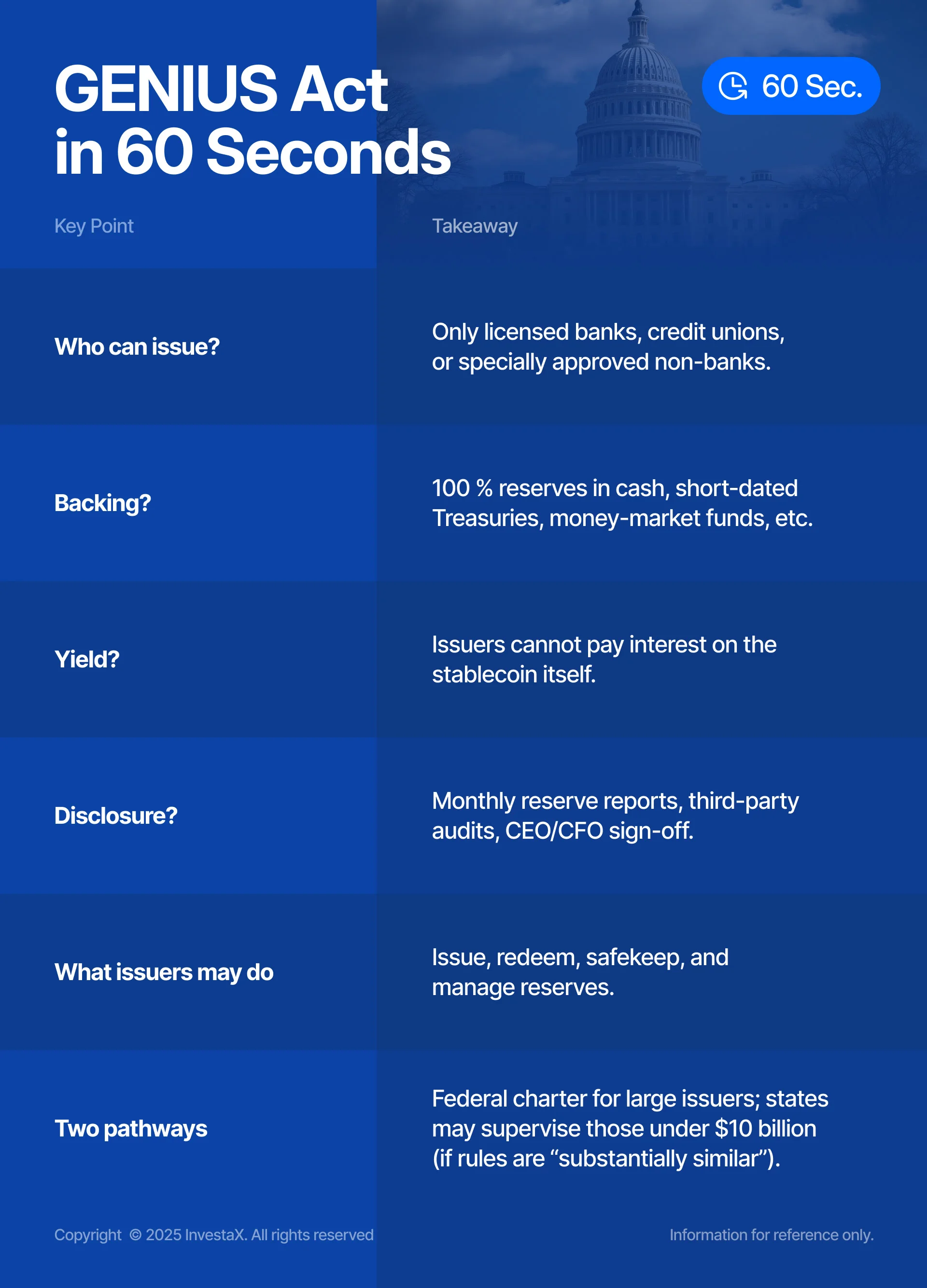The GENIUS Act, now law in the U.S., is reshaping how stablecoins are issued and used. While its main purpose is to provide a regulatory framework for payment stablecoins, the impact is already being felt across the broader digital asset landscape, including tokenized real-world assets (RWAs).
In our previous post, we explored how the GENIUS Act sets the stage for broader adoption of tokenized RWAs. Here, we zoom in on one emerging consequence: the shift of stablecoin capital into tokenized yield-generating products.
Stablecoins Get a Green Light. But With a Catch

Under the GENIUS Act, stablecoins like USDC or USDT must now be:
- Issued by licensed entities,
- Fully backed by liquid assets (such as Treasuries or MMFs), and
- Prohibited from paying interest to holders.
That last point - no native yield - is key. The law treats stablecoins like digital cash, not investment products. It also means that holding stablecoins won’t earn you anything on its own.
At the same time, with legal clarity finally in place, the market is gearing up for a potential surge in stablecoin supply. Analysts expect market capitalization to grow beyond its current ~$240 billion, potentially into the trillions as institutional use picks up.
So, what happens when stablecoin adoption accelerates, but yields vanish?
Why Institutions Need a New Yield Play
For fintechs, asset managers, and corporate treasuries, stablecoins have traditionally served two purposes: liquidity and settlement efficiency.
But as balances grow, so does the pressure to put those funds to work. Today, over $200 billion in stablecoins sit idle, earning zero yield. Moving that capital into DeFi protocols might offer higher returns, but it also introduces smart contract risk, unclear legal treatment, and non-institutional-grade infrastructure. For most regulated institutions, that’s not a viable option.
Instead, a growing number of players are looking to tokenized yield bearing products - the on-chain versions of money market funds, U.S. Treasuries, corporate bonds, and private credit.These are built to deliver:
- Stable and predictable returns (4–8% APY)
- Transparent, measurable risk (credit-rated assets and public portfolio data)
- Scalability that DeFi pools cannot match
Once you have a stable and predictable yield source, you can build products with confidence. DeFi yields are volatile and often capped. RWA yields are steady, auditable, and institution-ready.
Tokenized Treasuries Solve More Than Yield
The appeal is not just the return. Tokenized Treasuries and MMFs can also serve as collateral, giving institutions the ability to earn yield without sacrificing capital efficiency.
- Binance now accepts tokenized money market funds as collateral for institutional OTC trades.
- BlackRock’s BUIDL and InvestaX’s HYCB and MMF Earn products allow stablecoin holders to access real yields backed by established financial instruments like Blackrock ETF and Fidelity USD MMFs without leaving the regulated environment.
The market is expanding fast. According to RWA.xyz, total assets in tokenized Treasury products, including tokenized fund units and certain tokenized U.S. government bonds have risen 247% YoY to $7.3 billion as of August 2025. Funds managed by BlackRock, Franklin Templeton, and Janus Henderson Anemoy have seen the sharpest growth, with combined assets tripling in 2025.
Tokenized Private Credit: The Quiet Giant
Private credit is already the largest sector in tokenized RWAs, standing at $14.4 billion. While Treasuries have been in the spotlight due to high interest rates, the picture could shift if the U.S. Federal Reserve begins cutting rates.
As Treasury yields come down, the relative attractiveness of private credit, offering potentially higher and uncorrelated returns, could draw more stablecoin capital into this segment. For institutions, tokenized private credit provides:
- Access to yield premiums over public fixed income
- Diversification beyond rate-sensitive instruments
- Structures that can be tailored for specific risk/return needs
If rates ease, private credit’s role as a higher-yield alternative could grow even more prominent, making it a natural complement to tokenized Treasuries in stablecoin yield strategies.
A Market Poised for the Next Leg of Growth
The GENIUS Act effectively shifts the source of yield from the stablecoin layer to the asset layer. Instead of expecting passive returns from a stablecoin balance, institutions can swap USDC into regulated instruments like tokenized bonds, MMFs, and private credit to generate yield.
This mirrors traditional finance behavior:
- Keep capital in liquid instruments.
- Use transparent, short-term debt for yield.
- Avoid operational and regulatory risk from unvetted markets.
As InvestaX CEO Julian Kwan notes, “The driver of RWA adoption has always been simple math. $200 billion in stablecoins earning 0% will naturally look for 5% in tokenized Treasuries.”
With U.S. regulation now clearer, stablecoin supply could grow significantly, and more of that capital will seek tokenized yield strategies. Market data supports the trend:
- Tokenized RWAs now exceed $25 billion, up 111% year-on-year.
- Private credit remains the largest segment at $14.4 billion.
- Tokenized Treasuries account for $7.4 billion, with BlackRock’s BUIDL alone holding $2.9 billion.
What This Means for Institutions
For corporates, asset managers, and fintechs, the opportunity is two-fold:
- Deploy idle stablecoin balances into yield-generating tokenized assets.
- Leverage tokenized instruments as collateral, improving capital efficiency without leaving the regulatory perimeter.
With stablecoin regulation now settled and tokenization infrastructure maturing, institutional capital is positioned to drive the next wave of growth in RWAs. Tokenized bonds, MMFs, and corporate credit are likely to become the preferred path for regulated stablecoin yield strategies.
Interested in issuing tokenized yield strategies? Contact InvestaX to get started.